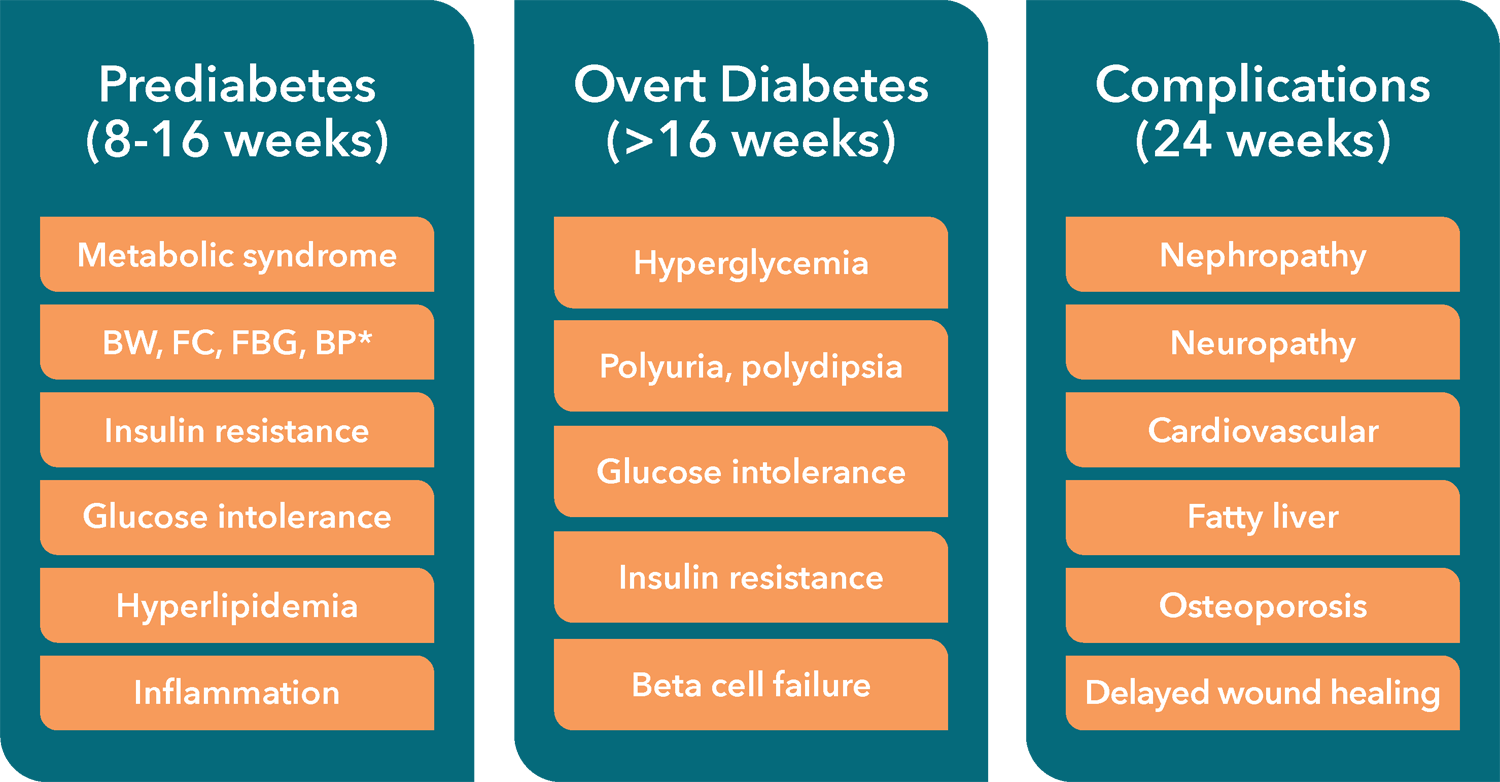- Services
- Therapeutic Areas
- Model Systems
- In Vitro
- In Vivo
- Technologies
- Service Type
- About Us
- Our Science
- Start Your Study Now
| Human | ZDSD Rat | ZDF Rat | |
|---|---|---|---|
| Prediabetic State | Yes | Yes | No |
| Intact Leptin Pathway | Yes | Yes | No |
| Beta Cell Failure | Late | Late | Early |
| Comorbidities | Many | Many | Some |
| Naphropathy | Yes | Yes | No |
| Cardiac dysfunction | Yes | Yes | No |

The ZDSD rat is an inbred polygenic model for metabolic syndrome, diabetes, diabetic complications, and obesity. It was developed by crossing the ZDF rat (Lean +/+) with the CD(SD) rat and selectively bred for obesity and diabetes traits, followed by inbreeding for more than 35 generations. Unlike other rodent models of metabolic disease, the ZDSD rat does not rely on monogenetic leptin or leptin receptor mutations for development of obesity and Type 2 diabetes, and therefore more closely mimics human disease development.
The ZDSD rat model displays:
Figure 1: Translatable Progression of Metabolic Syndrome and Diabetes in the ZDSD Rat

Modelling the disease progression from healthy to overt diabetes in ZDSD Rats. Choy S, de Winter W, Karlsson MO, Kjellsson MC. AAPS J. 2016 May 31. [Epub ahead of print] PMID: 27245226![]()
Changes in the fracture resistance of bone with the progression of type 2 diabetes in the ZDSD Rat. Creecy A, Uppuganti S, Merkel AR, O'Neal D, Makowski AJ, Granke M, Voziyan P, Nyman JS. Calcif Tissue Int. 2016 Sep;99(3):289-301. doi: 10.1007/s00223-016-0149-z. Epub 2016 May 21. PMID: 27209312![]()
Effect of dipeptidyl peptidase 4 inhibition on arterial blood pressure is context dependent. Jackson EK, Mi Z, Tofovic SP, Gillespie DG. Hypertension. 2015 Jan;65(1):238-49. doi: 10.1161/HYPERTENSIONAHA.114.04631. Epub 2014 Nov 3. Erratum in: Hypertension. 2015 Apr;65(4):e17. PMID: 25368027![]()
Characterization of diabetic neuropathy in the Zucker diabetic Sprague-Dawley rat: a new animal model for type 2 diabetes. Davidson EP, Coppey LJ, Holmes A, Lupachyk S, Dake BL, Oltman CL, Peterson RG, Yorek MA. J Diabetes Res. 2014;2014:714273. doi: 10.1155/2014/714273. Epub 2014 Oct 13. PMID: 25371906![]()
Raloxifene prevents skeletal fragility in adult female Zucker Diabetic Sprague-Dawley rats. Hill Gallant KM, Gallant MA, Brown DM, Sato AY, Williams JN, Burr DB. PLoS One. 2014 Sep 22;9(9):e108262. doi: 10.1371/journal.pone.0108262. eCollection 2014. PMID: 25243714![]()
A review of rodent models of type 2 diabetic skeletal fragility. Fajardo RJ, Karim L, Calley VI, Bouxsein ML. J Bone Miner Res. 2014;29(5):1025-40. doi: 10.1002/jbmr.2210. Review. PMID: 24585709![]()
Identification of glyceollin metabolites derived from conjugation with glutathione and glucuronic acid in male ZDSD rats by online liquid chromatography-electrospray ionization tandem mass spectrometry. Quadri SS, Stratford RE, Boué SM, Cole RB. J Agric Food Chem. 2014 Mar 26;62(12):2692-700. doi: 10.1021/jf403498f. Epub 2014 Mar 11. PMID: 24617284![]()
Age-related differences in response to high-fat feeding on adipose tissue and metabolic profile in ZDSD Rats. Davis JE, Cain J, Banz WJ, Peterson RG. ISRN Obes. 2013 May 20;2013:584547. doi: 10.1155/2013/584547. eCollection 2013. PMID: 24555150![]()
Multiscale analysis of morphology and mechanics in tail tendon from the ZDSD rat model of type 2 diabetes. Gonzalez AD, Gallant MA, Burr DB, Wallace JM. J Biomech. 2014 Feb 7;47(3):681-6. doi: 10.1016/j.jbiomech.2013.11.045. Epub 2013 Dec 6. PMID: 24360194![]()
Nanoscale changes in collagen are reflected in physical and mechanical properties of bone at the microscale in diabetic rats. Hammond MA, Gallant MA, Burr DB, Wallace JM. Bone. 2014 Mar;60:26-32. doi: 10.1016/j.bone.2013.11.015. Epub 2013 Nov 21. PMID: 24269519![]()
Skeletal changes associated with the onset of type 2 diabetes in the ZDF and ZDSD rodent models. Reinwald S, Peterson RG, Allen MR, Burr DB. Am J Physiol Endocrinol Metab. 2009 Apr;296(4):E765-74. doi: 10.1152/ajpendo.90937.2008. Epub 2009 Jan 21. PMID: 19158319
Get started today
© 2024 Crown Bioscience. All Rights Reserved.


© 2024 Crown Bioscience. All Rights Reserved. Privacy Policy
2022-12-14
2021-10-22
site_page